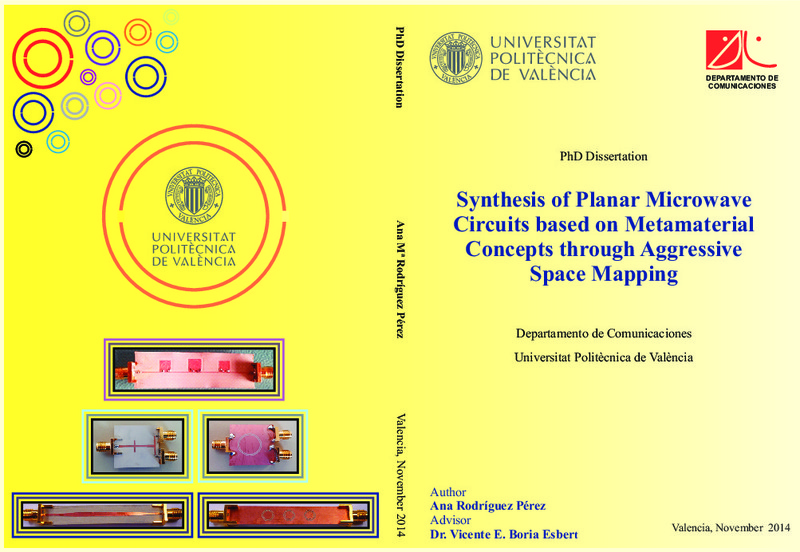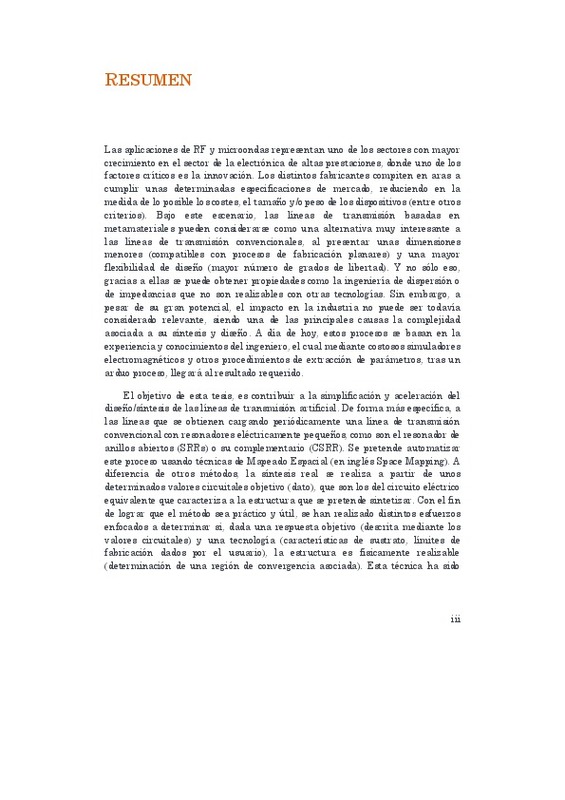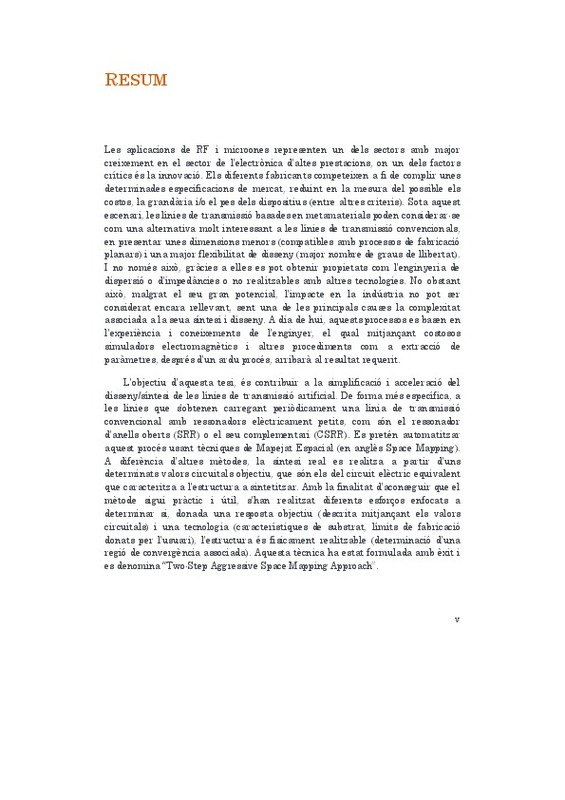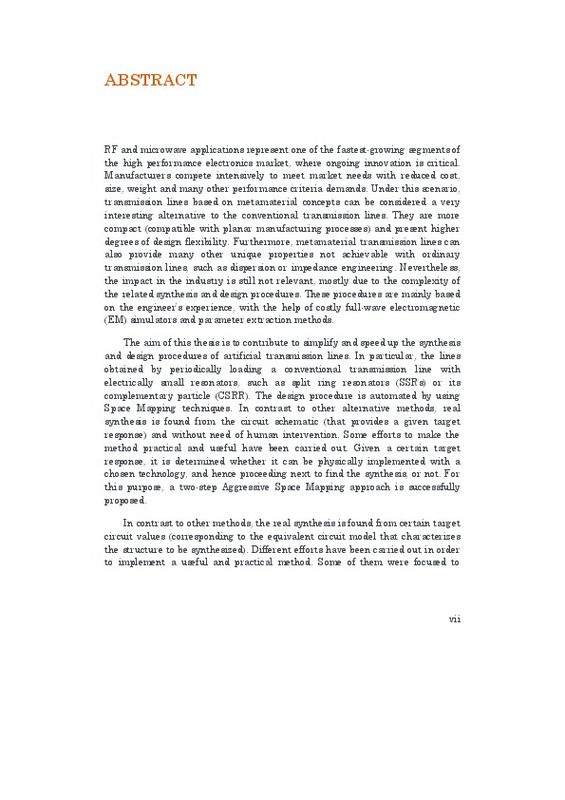- RiuNet repositorio UPV
- :
- Investigación
- :
- Tesis doctorales
- :
- Ver ítem
JavaScript is disabled for your browser. Some features of this site may not work without it.
Buscar en RiuNet
Listar
Mi cuenta
Estadísticas
Ayuda RiuNet
Admin. UPV
Synthesis of Planar Microwave Circuits based on Metamaterial Concepts through Aggressive Space Mapping
Mostrar el registro sencillo del ítem
Ficheros en el ítem
| dc.contributor.advisor | Boria Esbert, Vicente Enrique
|
es_ES |
| dc.contributor.author | Rodríguez Pérez, Ana María
|
es_ES |
| dc.date.accessioned | 2015-03-30T11:15:00Z | |
| dc.date.available | 2015-03-30T11:15:00Z | |
| dc.date.created | 2014-12-11 | es_ES |
| dc.date.issued | 2015-03-30 | es_ES |
| dc.identifier.uri | http://hdl.handle.net/10251/48465 | |
| dc.description.abstract | RF and microwave applications represent one of the fastest-growing segments of the high performance electronics market, where ongoing innovation is critical. Manufacturers compete intensively to meet market needs with reduced cost, size, weight and many other performance criteria demands. Under this scenario, transmission lines based on metamaterial concepts can be considered a very interesting alternative to the conventional transmission lines. They are more compact (compatible with planar manufacturing processes) and present higher degrees of design flexibility. Furthermore, metamaterial transmission lines can also provide many other unique properties not achievable with ordinary transmission lines, such as dispersion or impedance engineering. Nevertheless, the impact in the industry is still not relevant, mostly due to the complexity of the related synthesis and design procedures. These procedures are mainly based on the engineer’s experience, with the help of costly full-wave electromagnetic (EM) simulators and parameter extraction methods. The aim of this thesis is to contribute to simplify and speed up the synthesis and design procedures of artificial transmission lines. In particular, the lines obtained by periodically loading a conventional transmission line with electrically small resonators, such as split ring resonators (SSRs) or its complementary particle (CSRR). The design procedure is automated by using Space Mapping techniques. In contrast to other alternative methods, real synthesis is found from the circuit schematic (that provides a given target response) and without need of human intervention. Some efforts to make the method practical and useful have been carried out. Given a certain target response, it is determined whether it can be physically implemented with a chosen technology, and hence proceeding next to find the synthesis, or not. For this purpose, a two-step Aggressive Space Mapping approach is successfully proposed. In contrast to other methods, the real synthesis is found from certain target circuit values (corresponding to the equivalent circuit model that characterizes the structure to be synthesized). Different efforts have been carried out in order to implement a useful and practical method. Some of them were focused to determine if, given certain circuit parameters (which determine the target response) and certain given technology specifications (permittivity and height of the substrate, technology limits), that response is physically realizable (convergence region). This technique was successfully formulated and it is known as “Two-Step Aggressive Space Mapping Approach”. In this work, the latest improvements made till date, from the synthesis of basic unit cells until different applications and kinds of metamaterial-based circuits, are presented. The results are promising and prove the validity of the method, as well as its potential application to other basic cells and more complex designs. The general knowledge gained from these cases of study can be considered a good base for a coming implementation in commercial software tools, which can help to improve its competitiveness in markets, and also contribute to a more general use of this technology. | en_EN |
| dc.language | Inglés | es_ES |
| dc.publisher | Universitat Politècnica de València | es_ES |
| dc.rights | Reserva de todos los derechos | es_ES |
| dc.subject | Artificial transmission lines | es_ES |
| dc.subject | Open complementary split ring resonator (OCSRR) | es_ES |
| dc.subject | Metamaterial transmission lines | es_ES |
| dc.subject | Space mapping | es_ES |
| dc.subject | Automated circuit synthesis | es_ES |
| dc.subject | Split ring resonators (SRRs) | es_ES |
| dc.subject | Planar filters | es_ES |
| dc.subject.classification | TEORIA DE LA SEÑAL Y COMUNICACIONES | es_ES |
| dc.title | Synthesis of Planar Microwave Circuits based on Metamaterial Concepts through Aggressive Space Mapping | es_ES |
| dc.type | Tesis doctoral | es_ES |
| dc.identifier.doi | 10.4995/Thesis/10251/48465 | es_ES |
| dc.rights.accessRights | Abierto | es_ES |
| dc.contributor.affiliation | Universitat Politècnica de València. Departamento de Comunicaciones - Departament de Comunicacions | es_ES |
| dc.description.bibliographicCitation | Rodríguez Pérez, AM. (2014). Synthesis of Planar Microwave Circuits based on Metamaterial Concepts through Aggressive Space Mapping [Tesis doctoral]. Universitat Politècnica de València. https://doi.org/10.4995/Thesis/10251/48465 | es_ES |
| dc.description.accrualMethod | TESIS | es_ES |
| dc.type.version | info:eu-repo/semantics/acceptedVersion | es_ES |
| dc.relation.pasarela | TESIS\4317 | es_ES |
Este ítem aparece en la(s) siguiente(s) colección(ones)
-
Tesis doctorales [5389]












